The post “City of Yes”: Unlocking New York City’s Housing Potential appeared first on Blog.
]]>On December 5, 2024, New York City adopted City of Yes for Housing Opportunity, the most significant update to the city’s zoning code since 1961. The city faces a persistent housing shortage, with experts estimating that 473,000 additional housing units will be needed by 2032 to meet demand. City of Yes aims to address this this issue by increasing allowable housing density, facilitating office-to-residential conversions, and reducing parking requirements. In doing so, the initiative is expected to enable the creation of 80,000 new housing units over the next 15 years.
How City of Yes expands housing development
A key feature of the plan is the Universal Affordability Preference (UAP) program, which allows developers in medium- and high-density areas to build 20% more housing if the additional units are affordable to households earning 60% of the Area Median Income (AMI). This policy was designed to complement the 485-x tax incentive, ensuring that new residential projects remain financially viable.
The Floor Area Ratio (FAR) increases enabled by City of Yes vary by zoning district, street width, and whether the site is inside or outside the Manhattan core. Developments in historic districts still must adhere to the Landmarks Preservation Commission’s regulations to preserve neighborhood character.
Where does this create the biggest opportunity?
To better understand the impact of these zoning changes, our team at AECOM mapped the new maximum allowable floor area under the UAP program. By comparing previous limits with new maximums, our team identified neighborhoods with the greatest newly unlocked development potential. Use the interactive map below to explore the impact of the City of Yes in each neighborhood. To find a specific area, use the search function in the top right corner. The legend is found immediately below the search function.

Percent Increase in Maximum Allowable Square Footage by Neighborhood
Some neighborhoods saw substantial increases in their development potential. Park Slope and Prospect Heights in Brooklyn, along with Bronx Park in the Bronx, have seen the largest increases in maximum allowable square footage under City of Yes.
| Neighborhood | Percent Increase in Maximum Allowable SF |
| Park Slope (Brooklyn) | 19.8% |
| Prospect Heights (Brooklyn) | 17.6% |
| Bronx Park (Bronx) | 17.4% |
| Bedford-Stuyvesant (East) (Brooklyn) | 15.5% |
| Bedford-Stuyvesant (West) (Brooklyn) | 15.0% |
| Hamilton Heights-Sugar Hill (Manhattan) | 13.7% |
| Flatbush (Brooklyn) | 12.2% |
| Astoria (Central) (Queens) | 12.2% |
| Upper East Side-Carnegie Hill (Manhattan) | 11.7% |
| Sunset Park (Central) (Brooklyn) | 11.7% |
Available development rights by parcel
Our analysis also compared the existing built-out floor area with new maximums to identify unused development rights at the parcel level.
Most parcels receiving a Floor Area Ratio (FAR) boost under City of Yes saw an increase of less than 2.0. While these individual increases may seem modest, they collectively enable an additional 295 million square feet of development citywide.
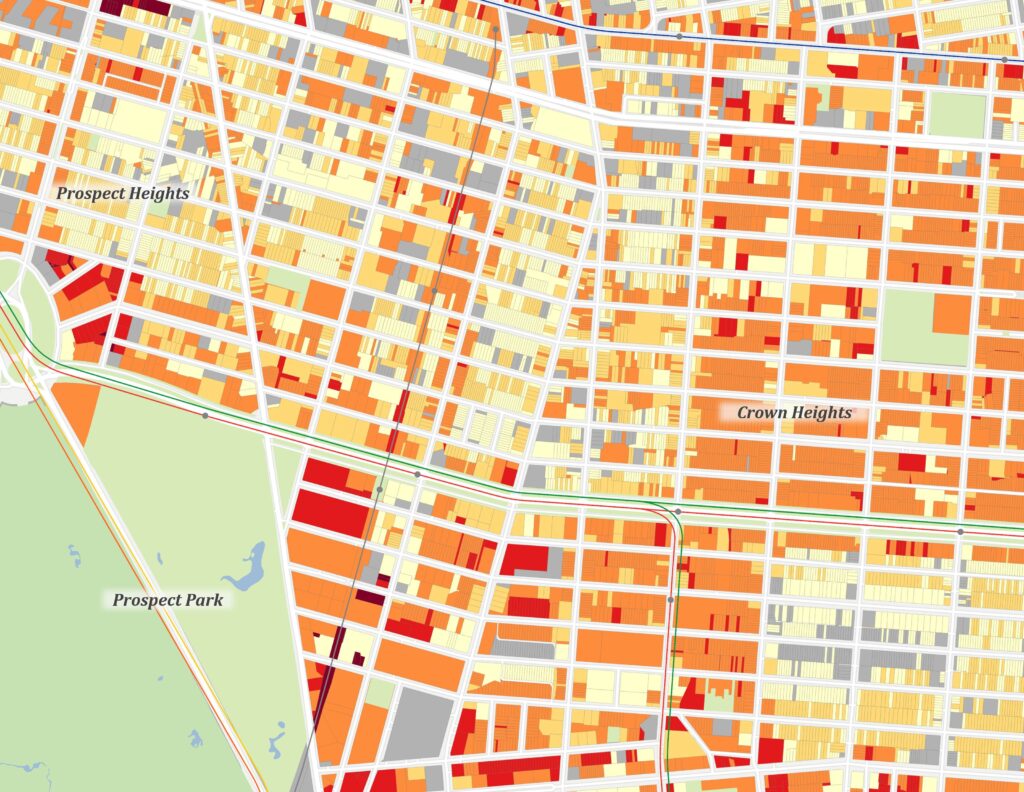

Many of the City’s most underbuilt parcels tend to be in commercially zoned districts, which are largely unaffected by the UAP program. For example, Atlantic Avenue-Barclays Center station in Brooklyn has a concentration of underbuilt commercial parcels near the transit hub, presenting an opportunity for additional transit-oriented development.
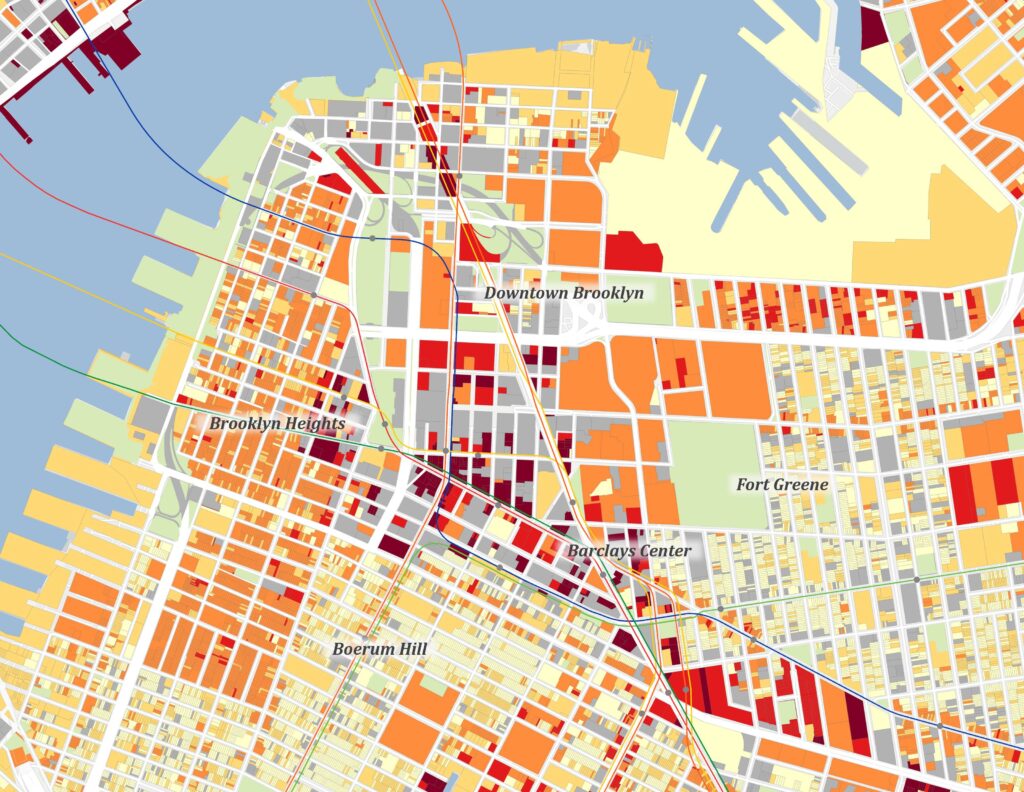

Beyond the UAP program, City of Yes also expands eligibility for office-to-residential conversions. Now, buildings constructed as recently as 1990 can be converted to housing in any area where residential uses are permitted. This shift could be particularly impactful in neighborhoods like Midtown Manhattan, where many office spaces remain underutilized.
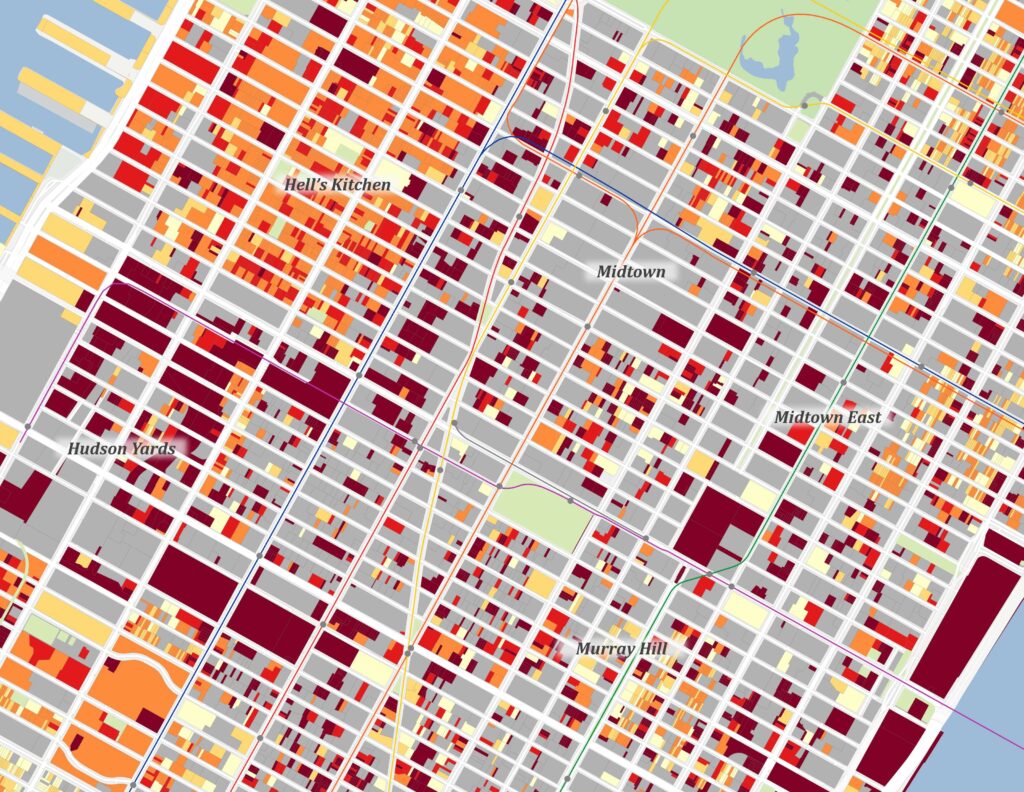

Use the interactive map below to explore untapped development potential by parcel under City of Yes.

Unbuilt FAR by Parcel
What’s next?
With City of Yes now in effect, developers, city officials, and community members have new tools to help address New York’s housing shortage. Understanding how these zoning changes impact specific properties and neighborhoods is key to making the most of this opportunity.
Interested in learning more about development opportunities under City of Yes? Reach out to our team at AECOM for data-driven insights and strategic planning support.
The post “City of Yes”: Unlocking New York City’s Housing Potential appeared first on Blog.
]]>The post Career Path Spotlight: Karen Campbell appeared first on Blog.
]]>This time, we connected with Karen Campbell, Vice President, Austin Metro+ Executive in the West region to learn how she progressed in her career path.
Hi Karen. What do you do for AECOM?
As Vice President, Austin Metro+ Executive, I wear two hats: Austin Metro+ lead and West Region Specialist Pursuit Team Lead. I’ve been at AECOM for 18 years working in our Denver, CO; Santa Ana, CA; and now Austin, TX office.
Tell us about your career journey and how you got here.
I started as a proposal coordinator in legacy company Woodward-Clyde’s Federal Services proposal center in Denver, Colorado. In this role, I was responsible for supporting senior proposal managers. After nearly two years, I started to lead my own major federal proposals and engaged directly with capture managers, project managers, and client account managers to prepare proposals and presentations. After five years, I applied for an internal open marketing position in Southern California to expand my skills from just federal to include state, municipal and private sector proposals.
After I transferred to our Santa Ana, California office, there was an open position to lead the Southern California proposal center. Even though I had fewer years of experience than suggested, I jumped at the opportunity and approached the office manager to give me a chance. We both took a leap of faith and worked closely together over the next four years to create a winning proposal center.
In 2003, I took another leap of faith and left AECOM to move to Hawaii and start my own soda company with my husband. As a new business owner, I was running every aspect of our company from accounting, marketing and business development to supply, production, customer and investor relations. Ten years and two kids later, we decided to move back to the mainland (Austin, Texas) to be closer to family and run the business remotely.
Using my network in California, I was introduced to the Process Technologies business leader in Austin who was hiring a business development/marketing lead for URS. I was fortunate that my 12-person interview panel was willing to listen to how someone working in the beverage industry for 10 years could transfer her skills into successful business development in the energy business. I worked for that group for three years. After AECOM acquired URS, I transitioned from the Process Technologies marketing lead to our new Oil & Gas Business Line marketing lead. After one year in this position, I became the Central Region Marketing Manager.
As the Americas regions evolved, I moved into my current role as Vice President, Austin Metro+ Executive where I have two focus areas. As West Region Specialist Pursuit Team Lead, I work on cross-business line opportunities, primarily for clients in our key cities. My team and I coordinate with Metro+ leads, market sector leads and client account management leads across the West Region to help position AECOM for strategic capital projects that require cross-business line solutions.
My other focus is Austin Metro+ lead, which I asked my manager to be considered for. In this part of my job I meet clients, partners and navigate the geopolitical scene. I find that my two hats complement one another. I am now involved from the investigative to winning stage for major pursuits in Austin.
What was a career defining moment for you?
My career defining moment was when I started my own soda company with my husband. We left full-time jobs, sold our house and used the proceeds to take on this exciting, scary, and fun adventure in Hawaii. The experience gave me the confidence and skills to approach my marketing position with AECOM in a much broader manner.
What’s something you wish someone had told you years ago?
Being scared is perhaps the best reason to try something new! I think it is important to challenge ourselves and to do what scares us – otherwise we may never learn our true potential.
What advice do you have for people who want to chart their career path at AECOM?
My advice is to understand what really drives you. Figure out which part of your job brings you the most joy and then discover how those specific skills can be applied to other career paths. Talk to people in a career path you’re interested in and ask questions.
Something I’ve noticed about careers at AECOM is that people can be on the same career path, but their approach and what they do once in their position can vary based on individual strengths. It is as important what we do as how we do it.
If not this path, what would have been your career plan B?
If living in the most remote island chain in the world wasn’t so difficult with two young children, I probably would’ve stayed in Hawaii to continue running our soda business. I loved the lifestyle, community and culture and am proud of what we created.
I also would have loved to be a stay-at-home mom. I was raised by a stay-at-home mom for most of my life and I cherished all the time we had together. I’d also dedicate my free time to support non-profit organizations specific to cancer charities and hospice care.
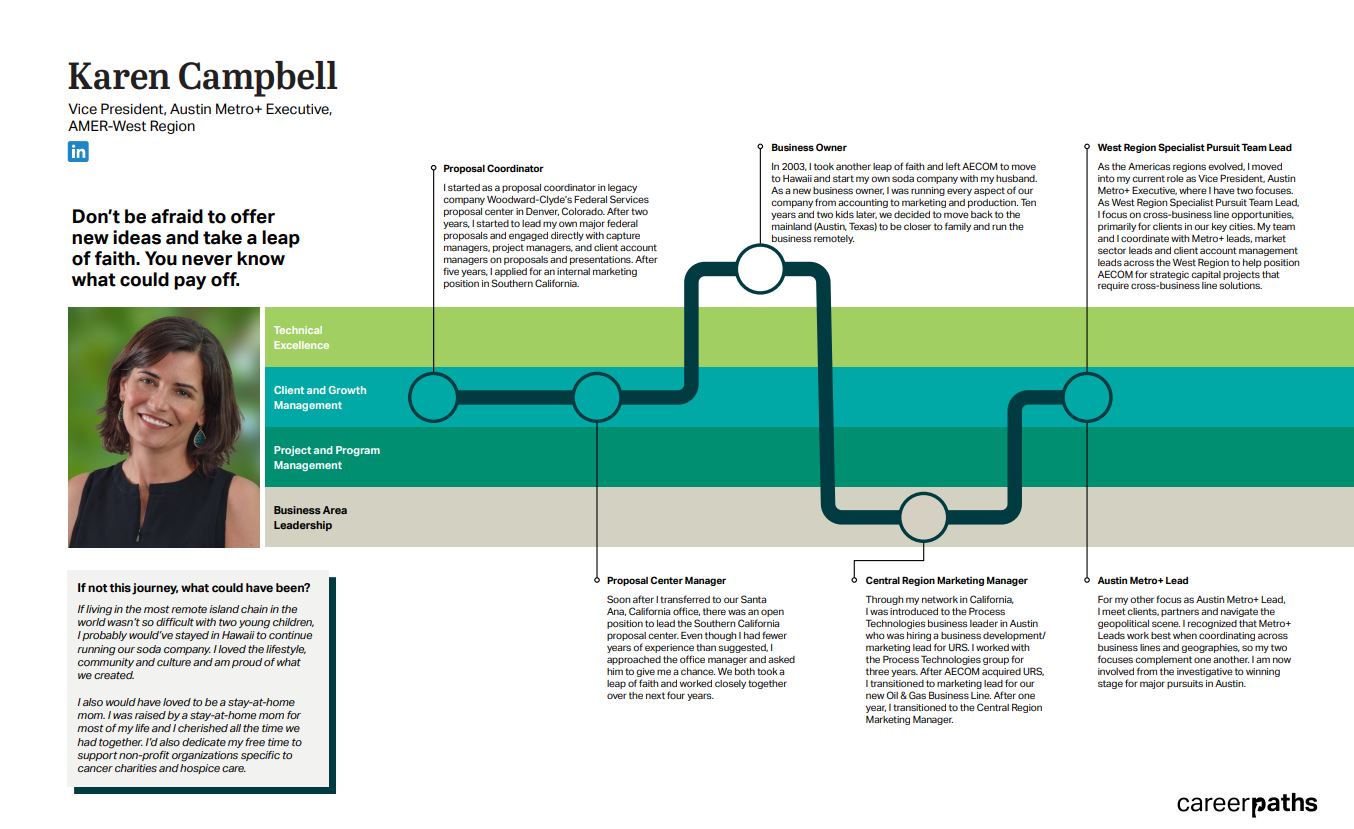
The post Career Path Spotlight: Karen Campbell appeared first on Blog.
]]>The post Deep Dive with Avinash Srivastava appeared first on Blog.
]]>This week, we are highlighting our global director of urban analytics from our Buildings + Places business and how he and his team have used their skills to help develop The Point Utah, a 600-acre innovation district outside of Salt Lake City. This sustainable and smart community is being built on the former site of a correctional facility.
During his 23 years in the industry, Avinash has worked at the intersection of technology, strategic planning, and design. Guided by a holistic, data-driven approach and focus on resiliency, he’s delivered large-scale master planning and urban design, smart city strategy, energy, and infrastructure planning projects worldwide. Avinash is the chief architect of AECOM’s Sustainable Systems Integration Model (SSIM ) — an award-winning digital tool for strategic master planning at site, city or regional scales and the Triple Bottom Line Assessment (TBL
) — an award-winning digital tool for strategic master planning at site, city or regional scales and the Triple Bottom Line Assessment (TBL ) for comprehensive multi-criteria analysis for infrastructure and design projects.
) for comprehensive multi-criteria analysis for infrastructure and design projects.
Tell us about The Point Utah. How are you and your team making this new community smart and sustainable?
Our involvement in the project began during the design competition and has continued through each subsequent stage. We’ve helped shape the different strategies for our client, The Point of the Mountain State Land Authority, to create an energy efficient, net zero, “15-minute” community. We developed a sustainability plan and a smart city strategy and are currently advising the selected developers on implementation and design refinements.
Our work for The Point focuses on optimizing water for this desert location, and in creating a net-zero carbon ready community which emphasizes quality of life through incorporating smart city, smart mobility and smart energy technologies.
Using SSIM, we assessed the sustainability performance and measured the cost-benefit of different strategies for reducing air emissions (including GHG), water pollution, water and energy use, and taking advantage of on- and off-site renewable energy resources towards achieving a net-zero carbon ready development. In this way, we’ve shaped the project by bringing the different stakeholders on board to support specific pathways for achieving sustainability and smart district goals.
Based on the SSIM findings, our team has provided design recommendations related to specific aspects of transportation, building design, ecology, waste management and water management. These recommendations include building efficiency specifications and rooftop solar integration, and the integration of secondary water for irrigation and toilet flushing systems.
The Point is also a case study for our B+P Technical Academy, where we’re educating new AECOM professionals on the process and tools behind the sustainability strategies and exploring new ideas to further improve aspects such as embodied carbon.
What was a key challenge you faced while working on this project? How did you solve it?
This project represents a very progressive vision for transforming state-owned land. By turning disused space into an innovation district, it will foster technological progress for anchor institutions, such as high-tech start-ups, scientific and educational organizations, and medical innovators, while also providing mixed-use housing, office, and retail space.
The challenge is achieving the extremely high level of sustainability that is part of the client’s vision — creating a net zero community — inside the surrounding community. Local utilities were following current regulations and legislation for Utah, where goals for clean energy sources are modest. We worked closely with utilities and all other stakeholders to make sure the project had buy-in at every stage. The client group and the board were integrally involved in overseeing this project and were committed to achieving the sustainability goals but had real cost and other implementation constraints. We were challenged to explore a range of solutions that can work within these constraints.
We developed a tool to help visualize the outcomes of the various scenarios while measuring the capital expenditures and operational costs tied to each scenario. The tool was a digital twin of the project that functioned like a game board where you can take any system — water, energy, transportation — and turn dials to include or exclude different types of strategies, such as rooftop solar or water reuse, and see the performance and the costs reported out in real time.
You can also see whether you’re meeting those specific benchmarks or targets and at what cost, as well as who will bear that cost. What’s the developer’s investment? Which costs will be recovered and realized by future tenants? What if we did this instead? How can we use alternative financing? The digital tool helped us answer these and other questions and this was quite effective in building consensus with the stakeholder group.
We brought forward many innovative cost-reduction strategies, including bringing in independent energy providers as partners, reducing operating costs to residents and commercial building owners through rooftop solar, paying the cost of investment over time through a community-wide solar cooperative and promoting electric vehicle adoption in and around the community.
From a technical standpoint, our approach to reducing carbon in building and water systems considered innovative trends and sustainability certifications such as Living Community Challenge, EcoDistricts, Envision, LEED for Neighborhood Development and others.
How has this experience shaped your approach to future work?
This project validated our approach to achieving project transparency through practical, realistic engagement. Using simulations and modeling, we showed stakeholders the results of “what if” conditions and helped them reach a consensus.
We can also use this approach to meet our ScopeX carbon reduction targets and make our projects more effective, while reducing the time to arrive at consensus so our clients can achieve their goals. We’re hoping to adopt this process across AECOM projects. This is the aim of the B+P Technical Academy, which reaches people and projects around the world.
Another key takeaway is the power of collaboration. Our project team (including AECOM’s multidisciplinary team and other experts brought in by the client) has worked as a cohesive unit to create the best outcome for our client. The expertise at AECOM and our ability to tap into multiple disciplines and subject matter experts provided the foundation for this integrated approach.
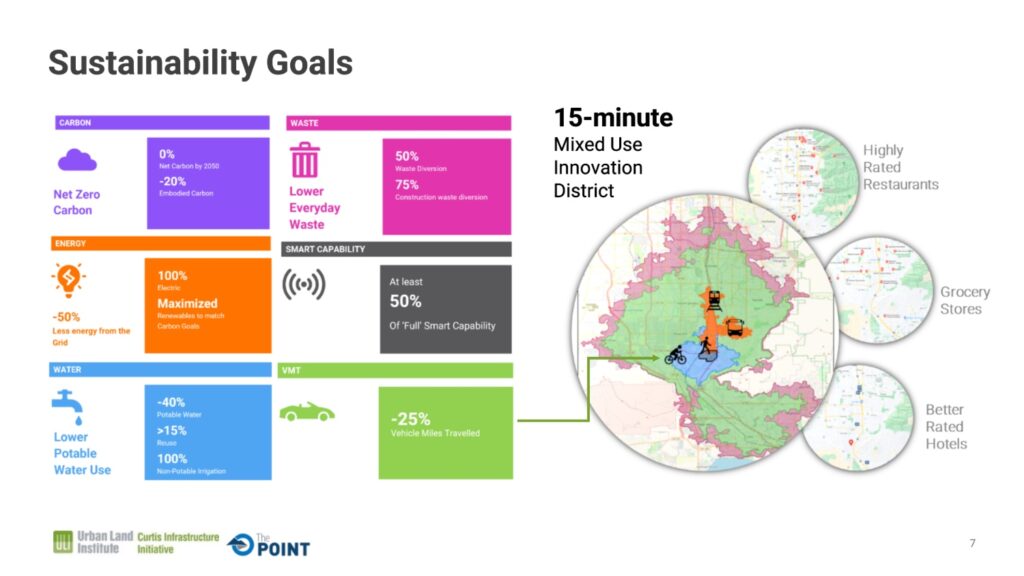
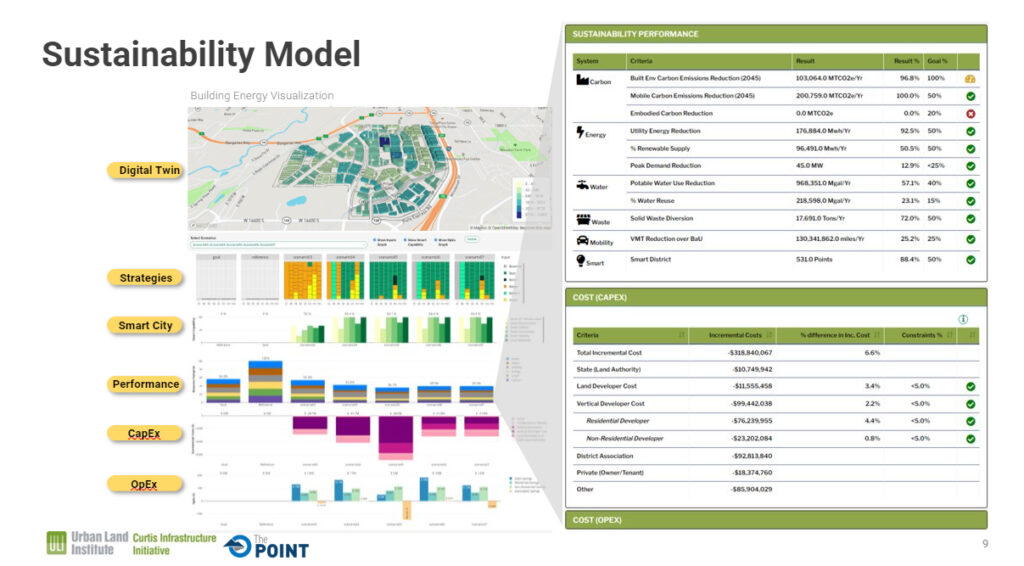
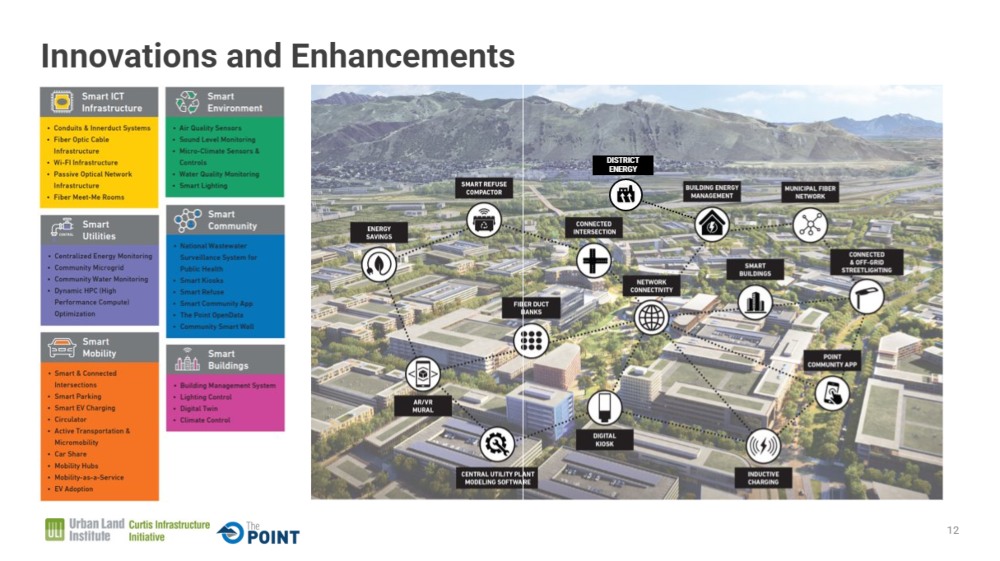
The post Deep Dive with Avinash Srivastava appeared first on Blog.
]]>The post Design to scale: How to develop adaptable office spaces appeared first on Blog.
]]>Considering solutions through the lens of multiple scales — the city, the block or campus, the building and the office space — is an approach to designing offices that fosters interpersonal connections and integrates adaptability at its core, while inherently offering solutions that break down complexity. Designing to scale advances a balanced approach for occupants, while incorporating the feasibility and flexibility developers and landlords need to meet their current and future objectives. Here are four principles to consider when implementing this concept.
Context
Design in the context of multiple scales is key to delivering this essential balance. At each scale, designers consider the needs of building occupants, corporate owners, lessees, landlords and developers. To develop spaces that work across contexts, designers focus on functionality and adaptability from the broadest view — the city or location — progressively zeroing in on each level from a city block or suburban campus, an individual building and finally to the office space. Design priorities correspond to these scales, ranging from integrating into existing infrastructure and public spaces at the location scale to supporting social connections at the office space scale.
Incorporated into each of the various scales, designers address features to enhance workforce health. This begins with evaluating city- or location-specific needs ranging from connected spaces and available surrounding services to the setting on a block or a campus where designers consider green spaces that support wellness and encourage community interactions.
Our professionals explored this concept at Commerce Metro Center in Reston, Virginia, where we developed a masterplan for 12 acres of land that integrated existing office buildings with new mixed-use buildings along a transit hub. The plan is organized around a public space spine linking restaurants and outdoor dining with hotel amenities, office lobbies, residential buildings and the metro on one seamless level, addressing many aspects of the live/work/play triangle.
Flexibility
The pandemic super-charged trends that were already in motion with many more people now balancing a hybrid schedule of in-person and remote work. Developing designs that emphasize flexibility at various scales and consider who uses the office space and how — now and in the future — benefits occupants as well as owners, developers and landlords. Design aspects can range from creating shared public spaces within private buildings to developing smart systems that maximize building occupancy and providing reconfigurable spaces that encourage personalization.
Resiliency
Climate change presents new challenges to business operations. If office spaces are not designed with resiliency in mind, they present the potential for costly interruptions or shutdowns. Incorporating forward-thinking resilient elements, at multiple scales, allows office spaces to maintain operations. For example, offices in areas prone to flooding may locate backup generators on high floors to minimize potential flood impacts or place parking at ground level so essential office functions are elevated above the flood zone.
Equity
An increased focus on equity is leading designers to balance office and hybrid workers’ needs. Developing a distributed real estate model that improves accessibility is a primary consideration, with design solutions that provide inclusive, flexible spaces to increase desk availability if more capacity is needed on days when remote workers report to the office.
Into the future
With new workplace and workforce trends taking hold in the corporate and commercial sector, businesses are recognizing the importance of how office spaces function within broader ecosystems – physical, virtual, public, private, social, individual — that create value. A design approach that thoughtfully considers multiple scales and meets the critical life/work/play balance is emerging as a new design standard, one that will serve us all well into the future.
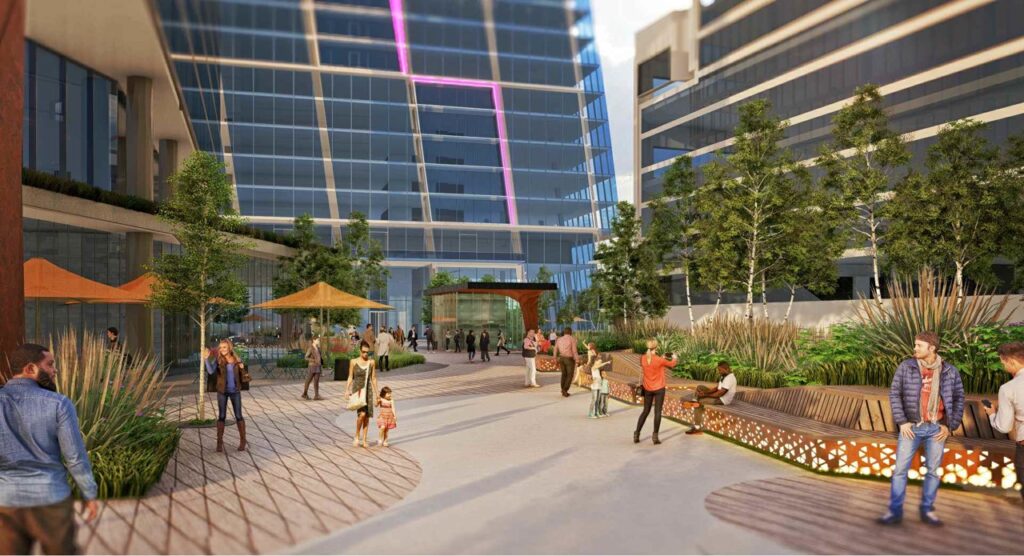
The post Design to scale: How to develop adaptable office spaces appeared first on Blog.
]]>The post COP26 in Glasgow: Tools for creating a just transition in UK cities appeared first on Blog.
]]>COP26 has begun and world leaders are gathering to agree on new carbon reduction targets. For resilience and net zero strategies to succeed in the long term, however, new infrastructure needs to be designed specifically to have a positive impact on the communities it serves.
In the UK, climate change and the levelling up agenda are forcing a rethink on infrastructure investment. That is certainly the case in Scotland, where legislative framework for emissions reduction is underpinned by a legal commitment to deliver a ‘just transition’ defined as ‘both the outcome – a fairer, greener future for all – and the process that must be undertaken in partnership with those impacted by the transition to net zero.’
As infrastructure and built environment consultants, we take different approaches to creating the equitable infrastructure needed to meet wider levelling up and net zero ambitions, from integrating the use of nature-based solutions, to placing a higher weighting on socio-economic factors in transport planning to make sure that areas of low long-term investment are brought to the forefront.
In Glasgow, several schemes of strategic importance that manage excess surface water have been initiated in the city region under the Glasgow City Region City Deal and through the collaborative Metropolitan Glasgow Strategic Drainage Partnership (MGSDP). One of these projects is in Drumchapel, an area of deprivation identified as needing further support to tackle complicated socio-economic issues. As well as protecting areas downstream from flooding, the project needed to deliver additional social value for local people and work in the longer-term.
Looking at the flood management scheme through an environmental lens helped achieve these aims. We embedded the landscape team, which included our in-house ecologists and arborists, with the planning and engineering team from the outset. This gave us a multidisciplinary capability, meaning that we were able to use natural restorative processes to cost-effectively enhance traditional engineering solutions. For example, we knew that local people had difficultly traversing the site, so we installed robust bridges to make accessible crossing points over the Garscadden Burn, ensuring that the footpath gradients were suitable for wheelchair users.
In addition, we chose native species to replicate the natural habitat and planted an understory of native ground cover, a wetland meadow mix and trees that will need minimal intervention over the five-year implementation period. To be successful, however, this approach requires hard evidence and a very firm understanding of existing soil, hydrology, weather and climate conditions.
To achieve a just transition to a low carbon urban economy, new infrastructure must have a positive impact on the communities it serves. Within the public and political environment of delivering transformational net-zero strategies, decisions regarding new infrastructure must be transparent, robust and backed by well-researched hard evidence, of which local knowledge and community feedback must be a huge part.
The importance of continuous monitoring and evaluation of schemes, and listening to those affected, will only improve how projects are delivered in the future by building confidence and strengthening the case for change.
Click here to read the full version of this article, which explores further approaches to creating equitable infrastructure. In it, we draw on strategically-important transport planning and active travel projects across other major UK cities including Edinburgh, Manchester and Birmingham.
The post COP26 in Glasgow: Tools for creating a just transition in UK cities appeared first on Blog.
]]>The post Vertiports: The future of flight infrastructure is green appeared first on Blog.
]]>What are eVTOLs? Powered by electricity, eVTOL take off vertically like a helicopter, and fly horizontally like a traditional airplane. Differing from its predecessors, eVTOLs are technology-heavy, featuring virtually silent electric motors or rotors that communicate with the batteries that power them – functions that require sophisticated proprietary software and charging technology. As a result, we are seeing eVTOL developed by technology companies that have hired experts from the aviation industry.
This new transportation mode may improve mobility by quickly transporting small numbers of people within cities and across regions. They may also provide the rapid response logistics needed for emergency situations and increase small and rural market access.
How might they operate? There are currently two passenger transportation models, each designed to accommodate specific needs and functions. The first is based around vertistops, which is envisioned for urban locations and designed for short hops that allow for easy mobility within cities. These can be placed on existing infrastructure such as building tops or other unused spaces. The second model is compatible for intracity travel within a 150-mile range, restoring regional air service discontinued by traditional airlines due to cost considerations. Longer range eVTOL might require vertiports, stand-alone terminals, Maintenance Repair and Overhaul (MRO) operations and charging facilities within existing airports, greenfield sites or on top of other existing infrastructure. As a faster way to travel, eVTOL may replace cars, regional trains or buses, with many developers and manufacturers focusing on making eVTOLs affordable and accessible.
Vertiports: green infrastructure required. With many eVTOL developers aiming to launch by the year 2024 with the potential for established networks by 2030, these aircrafts represent an entirely new zero carbon industry that must be served by a new type of conducive infrastructure. With these aircrafts not always depending on airport access, our AECOM team is currently studying the re-purposing of existing, non-traditional infrastructure such as parking garages and distribution facilities. The aircraft may also use existing logistics facilities as vertiport hubs and nontraditional rural locations, such as repurposed roadway infrastructure, as logistic hubs, significantly improving supply chain speed and remote location access.
As with all electric vehicles, eVTOL will increase energy demand. Grid upgrades will be needed to supply the energy required for battery charging and cooling. To complicate matters further, these aircrafts are expected to vary in size, each with proprietary charging methods and requirements specific to the manufacturer. Because of this, these vertiports and vertistops will require facilities to support multiple eVTOL designs and charging types.
What are the challenges in development? Federal, state and local governments are working with developers to create necessary practices, regulations and certifications, with a strong emphasis on flight standards. Given their similar range of motion to helicopters and airplanes, the industry is using those standards as a preliminary form while working to develop one overall flight standard. AECOM is actively involved in this process with several agencies that are driving policy around the future of eVTOL, such as NASA and North Central Texas Council of Governments (NCTCOG). In addition, AECOM holds a board position on the City of Los Angeles Urban Movement Lab, which is a dynamic collaboration between communities, local government and mobility innovators.
Establishing a new industry demands experience and insight. AECOM is meeting those needs by providing expertise to private developers, airport agencies and eVTOL developers. Recognizing our focus on the future of infrastructure and global airport experience, eVTOL manufacturers are presenting their business models and technical capabilities to our design professionals to help determine feasibility in their ideas and designs. And our familiarity with eVTOL is driving airport authorities, private developers and infrastructure providers to AECOM for assistance in determining potential preparations and support required to make eVTOL viable.
These efforts may seem like to be a heavy lift but with advanced technology and our integrated expertise combined with manufacturer, federal, state and local government focus, eVTOLs are poised for a smooth takeoff and with them, a more sustainable, equitable future for aviation.
The post Vertiports: The future of flight infrastructure is green appeared first on Blog.
]]>The post The Richmond 300 master plan: Incorporating equity and inclusion to improve quality of life appeared first on Blog.
]]>The result is Richmond 300: A Guide for Growth, a plan five years in the making that recently earned the American Planning Association’s 2021 Daniel Burnham Award as the nation’s top comprehensive plan. The master plan envisions an equitable, sustainable and beautiful Richmond that delivers a high quality of life for all residents. It incorporates such goals as creating inclusive housing, developing an equitable transportation network, fostering a diverse economy and supporting a thriving environment.
Here are six takeaways from this City of Richmond/AECOM collaboration that can help guide the development of master plans for other municipalities across the country looking to embrace a new sustainable future for all residents.
Break the mold. Typically, cities lead their master plan development, researching current conditions, developing their project scope and establishing targets before hiring a consultant to determine how to meet those goals. The planning director for the City of Richmond made the deliberate decision to move forward without these elements in place, underscoring the city’s desire for a more inclusive master plan that would consider the needs of underserved neighborhoods that historically had been shut out of these efforts.
This led to a master plan tailored to Richmond that accounted for needs voiced across all the city’s communities. While the city did not have the capacity to dedicate its personnel to the master plan full-time, AECOM embedded itself within the city, temporarily relocating their offices for the project. This close relationship allowed for open, in-person discussions between AECOM and city staff, cementing the team’s ability to serve as trusted advisors in a more meaningful, impactful way than would be possible with a traditional consultant.
Be open with the public. We were vocal about the process of creating an inclusive roadmap to guide the master plan’s development and sought input from the public from beginning to end. An example of this was how we formed the master plan’s steering committee. Typically, city officials appoint members for a steering committee before hiring a consultant, but Richmond wanted all voices to be heard. So, the mayor hosted a press conference where he asked citizens to apply for the plan’s committee and over 170 people expressed interest. The final committee consisted of 21 people varying widely in age, planning knowledge, and length of city residency. This diversity set the stage for an inclusive, transparent process and allowed us to create accessible, understandable content that resonated with our constituency and built community consensus.
Change the information flow. During the engagement process, we reversed the traditional top-down approach so that information flowed from the community up to the planners — a shift that allowed more people to contribute to the master plan.
We asked Richmond residents to send in their ‘Big Ideas.’ We received about 6,000 submissions, with over 900 vision statements that were then organized and brought to five working groups that were assigned to shape these submissions into draft maps, goals, objectives and recommendations. All Richmonders were invited to participate in these working groups with the expected commitment to attend all the meetings. Staff asked key technical experts from inside and outside City Hall to participate in the working groups as well, providing guidance and insight. Ranging between 30 and 50 unique members each, the groups worked with staff to fine tune the draft master plan during 15 meetings over five months. Once the working groups made their determinations, we brought the draft back for public review. The planning process began with Richmonders’ ideas and ended with their buy-in, giving all residents the opportunity to have a voice in the process and ownership of the adopted plan.
Shift gears when needed. We understood there would be times when a strategy or process didn’t work. To counter that, we built in time to reconsider and readjust, doing just that with our community engagement efforts.
We aimed to engage two percent of Richmond’s population — about 6,000 people. This target was intended to include people who are typically involved in planning conversations, such as residents who are active in civic associations, as well as residents from Black and Latino neighborhoods who have been less likely to be included in this process in the past.
When, after our first round of engagement, we lacked input from that second group, we readjusted our approach and hired seven residents from the communities we wanted to reach. These residents expanded input by using their community networks to discuss the plan and shared their feedback with the planning team, allowing us to build the inclusivity that was required in our approach.
Reach out for expertise. As a global firm, AECOM has a depth of resources to draw on to address specific needs that arise during the master planning process. When developing ways to address heat islands — areas that experience increased heat within Richmond’s neighborhoods — we reached out to our colleagues who specialize in resiliency and sustainability. Based on their input, we worked with local researchers who mapped out the locations of these heat islands. The researchers found that these areas aligned with disinvested, minority neighborhoods. As a result, we devised strategies for increasing the presence of and access to greenspaces, providing greater equity for these communities.
Take action. The Richmond 300 master plan encompasses 17 goals, 70 objectives and more than 400 strategies, but unless these recommendations are acted upon, it’s only a document. Richmond is investing in bringing this plan to life. The city is rewriting zoning ordinances to deliver more parks, greenspaces and housing units throughout the city. Richmond is also using Richmond 300 to guide the redevelopment of over 100 acres of city-owned land scattered throughout the city into a blend of mixed-income housing, job-generating commercial uses and open space. And plans are in the works for a deck to be built over the interstate to reconnect a Black neighborhood that was cut off from the rest of the city decades ago. These are the first of many steps the city will take as it prioritizes equity, sustainability and inclusivity to build upon its motto – “One Richmond.”
The post The Richmond 300 master plan: Incorporating equity and inclusion to improve quality of life appeared first on Blog.
]]>The post Supporting safe roads for all appeared first on Blog.
]]>As part of our continued focus on safety, we’re demonstrating our commitment to road safety by supporting the 6th Annual United Nations Global Road Safety Week. Simply put, low speed streets save lives. This year’s U.N. program focuses on keeping the streets and roadways safe where we live, work and play. There is considerable focus and urgency on this issue because everyone deserves the safety of low-speed, livable streets, which can have an effect on public health through the reduction of injury causing vehicle accidents and impact climate change by reducing vehicle emissions. This focus can also promote social and racial equality as a large portion of speed-related incidents occur in underserved communities.
Speeding is one of the top causes of roadway incidents around the globe, and as a globally focused organization, AECOM has signed the “Streets for Life: For People and Planet” open letter that calls on policymakers to act for low speed streets worldwide, limiting speeds to 20 mph (30 km/h) where people walk, live and play.
As the world’s premier infrastructure consulting firm, AECOM has helped conceptualize, develop, construct and operate transportation and roadway infrastructure projects around the world — from Honolulu to Hong Kong, and from Mumbai to Memphis to Melbourne. We have always placed a strong focus on roadway safety both in design and execution.
To achieve this, we have developed procedures and systems that include driver safety training for our more frequent business drivers, journey management planning, and design and quality checks. We’ve brought in foremost industry experts — the best and brightest from around the world to ensure that we continue to provide the high-quality expertise and delivery our clients expect from us, with an unwavering focus on safety. Road and driving safety is of particular importance to our company due to our exposure to the risk associated with it. Specifically, despite our project and geographical diversity, driving is one of the few risks that everyone is exposed to regardless of business.
You can learn more about the U.N.’s Global Road Safety Week by visiting the program’s website and you can view the open letter here.
The post Supporting safe roads for all appeared first on Blog.
]]>The post Reversing disparity with infrastructure policy, practice and investment appeared first on Blog.
]]>As architects, planners and designers, we can use data-driven tools and analytics to create an equity-based approach to infrastructure. To be successful, this approach should include proactive development of policies, practices and strategic investments to reverse disparity trends based on race, gender, sexual orientation or income. In order to create and facilitate more equitable infrastructures and societies, cities must analyze when and how decisions are made and how these decisions impact the most vulnerable communities. Here, we share how policy, practice and investment can help reverse infrastructure inequality.
Acknowledge the structural bias and lack of social equity in the current systems
To achieve more equitable communities, we must first acknowledge the current and historical disparity in the distribution and access to infrastructure and services, which disproportionally effects certain populations. It is critical that the larger community recognize and buy in to the efforts needed to mitigate the disparity and improve equity for all. We must also set specific goals and adopt policies to set this in motion.
Develop and adopt an equity-based framework for key decision-making
Not only can we embed equity into infrastructure decisions and prioritizations, we can make those considerations and the decision process visible through an equity-based framework, or Equity Lens. By viewing development options through an Equity Lens, key decision makers can understand the equity implications of each action as well as resulting performance and cost. The Equity Lens can be applied to individual projects as well as broader programs which will allow capital planning budgets to fund projects which address equity issues and performance gaps.
Use data-driven tools to incorporate equity in infrastructure decisions
With the right data-driven tools, incorporating equity-based thinking in planning and programming projects can become an intuitive and straightforward part of the process. With automated tools to guide city engineers, planners and policy makers through an equity-based process for project and program development, we can help achieve important equity goals and outcomes. When these tools are aligned to existing workflows, are user-friendly, transparent and accessible, cities and agencies can make decisions that are not only cost effective and high-performing but can also help to reverse disparity.
Track progress over time
While we cannot solve decades of inequity overnight, we can make progress working together on small and large efforts, incrementally and persistently. By tracking progress through real quantifiable metrics, creating department and agency accountability with regular reporting requirements and review by City Councils and the public, we can propel meaningful change in our communities.
Empower the community
Communities need a real voice in this process and should participate not just through engagement and outreach for a plan, but also in setting specific equity outcome goals. A regular equity dialog between citizens, policymakers, and project engineers is essential. Discussions around education, awareness, and citizen advocacy can positively affect how equity considerations drive critical infrastructure decisions. If we can create a system for continued feedback and channel that into the evaluation framework, we can not only empower our communities but begin to create equity in our built environments.
Project Highlight:
Baltimore’s Equity-Based Project Prioritization Tool
In Baltimore, we are working with the Department of Public Works to prioritize capital investment for infrastructure projects. Which projects should move forward? Equity is the priority. By using this online tool developed by AECOM, the Department of Public Works can view projects through an ‘Equity Lens’ which aggregates data such as percentage of disadvantaged and/or minority populations within the project area and enables the City to evaluate multiple locations. Each potential infrastructure project receives a scorecard for project performance, equity and combined performance and equity to help the City make the most equitable infrastructure investment choices.
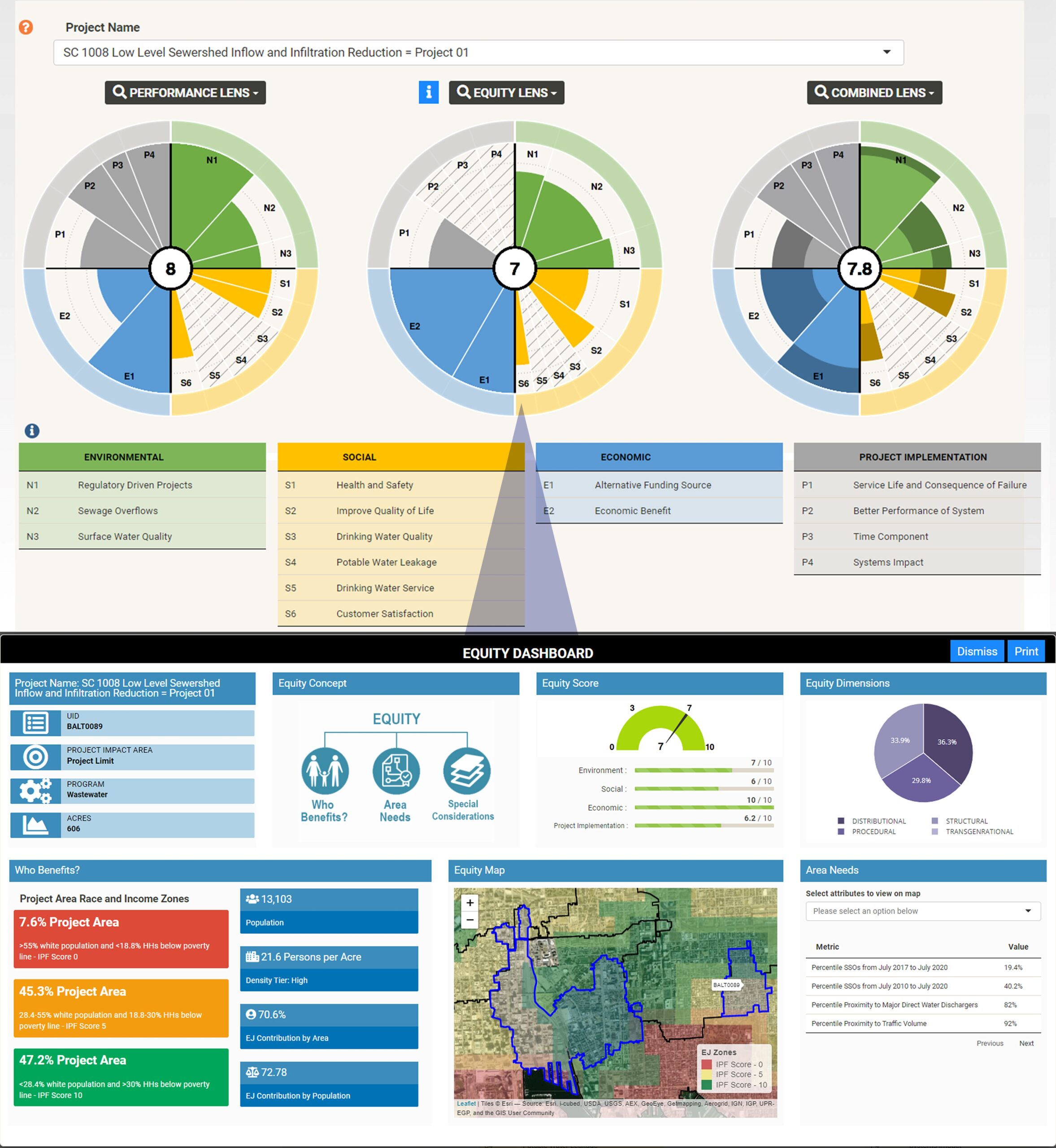
The post Reversing disparity with infrastructure policy, practice and investment appeared first on Blog.
]]>The post Transit Forecasting, Scenario Planning and Budgeting in the Age of COVID-19 appeared first on Blog.
]]>While the transit industry continues to hope for clarity, there are avenues that agencies can pursue to help shore up transit’s future, many stemming from tools that can gather and deliver information. On the passenger side, tools such as rider information applications can help revive rider confidence. For agencies, forecasting and scenario planning can enable informed decisions concerning funding, budget allocations and resources. These efforts together will help keep transit rolling by supporting healthy cities and thriving state economies.
Here are three ways that these tools can help cities maintain the health of their transit networks.
Instilling rider confidence
The future of transit is intrinsically linked to its ridership — which has dropped dramatically as a result of the pandemic. COVID-19 has taken a toll on riders’ confidence in transit safety, with many believing there is a connection between transit use and contracting the virus, despite reports refuting these links. A recent report from the American Public Transportation Association indicated there is no direct correlation between the use of public transit and contracting the coronavirus. The New York Times supports this statement, specifically highlighting conditions in New York City, stating that New Yorkers tend to practice social distancing as they travel on subways and buses while also wearing masks and avoiding talking, eating or drinking.
Regaining rider confidence is essential to the health of our transit systems. Transit agencies can help riders feel more comfortable by prioritizing system cleaning and disinfecting. This, along with providing clear passenger information can enable riders to safely schedule their trips and address their concerns. AECOM provided cleaning and disinfection protocol guidance to Southeastern Pennsylvania Transportation Authority (SEPTA) to help protect against COVID-19.
While emphasizing the importance of wearing masks and practicing social distancing, transit agencies are also implementing technologies like automated passenger counting, touchless fare payment systems and integrated intelligent solutions to safeguard riders and workers. For passengers, AECOM’s Transportation Resilient Integrated Passenger Solution (TRIPS) provides an integrated approach to safety by enabling riders to plan their rides for when there are fewer people using the system.
Offering options and information
Tools such as scenario planning — looking at potential occurrences and delivering insight related to different mobility conditions and budget allocations — are increasingly important. Scenario planning and forecasting tools such as AECOM’s MobiliticsTM provides agency executives with varied alternatives and up-to-date information giving them if/then scenarios to plan for appropriate mid-, short- and long-term budgetary allocations that can help maintain transit health beyond the short term. Investment is important to the next wave of transit advances — including electrification. Scenario planning can highlight risks and tradeoffs and help to balance immediate concerns with long-term goals.
Options and information are especially important as we continue to manage transit systems in the age of COVID-19, which to date is impacting how many passengers use transit and how. New Jersey Transit is employing AECOM’s MobiliticsTM scenario planning tool as well as near real-time anonymized cell phone data to understand behavioral changes, shifts in travel patterns and technology advancements. Together with data analysis, this informs current and future service enabling adjustments around technology and pandemic-related factors and allows for informed budgetary decisions.
Managing resources
Effective transit management can be challenging in the best of times and is even more so during a global pandemic. Agency executive officers, currently focusing available resources on their short-term survival options, may be left with little in reserve for mid- and long-range recovery. It is vital that they move past this thinking as quickly as is feasible and aggressively pivot to comprehensive planning and development of mid- and long-term funding solutions, which I discussed in my previous blog, “Transit Funding in the Age of COVID-19: IT’s Time to Think Beyond the Stimulus.”
In the meantime, scenario planning can help transit agencies develop appropriate resource and budget allocations by providing them with information needed to make the decisions that will put their systems on firmer footing now and in the future. Even in a more typical, everyday scenario, funding and investing in transit electrification has great bearing in equity, climate change and resilience.
These efforts, which are now even more important to the future of transit, require that agencies pursue a paradigm shift toward innovation for new revenue streams including the advancement of vehicle electrification as an essential support. Agencies are investing in electric buses as a means of cutting greenhouse gas emissions as well as the development of new jobs for skilled workers who can advance the infrastructure needed to support this next wave. AECOM has experts in place to help with the analysis by highlighting risks and tradeoffs to help balance immediate needs and long-term goals.
As the pandemic continues, ridership will continue to fluctuate, and transit agencies will be hard pressed to determine the appropriate short- and long-term investments and budget allocations for their respective systems. Transparency with riders, combined with adherence to disinfectant protocols and the use of scenario planning tools, can help ensure that they maintain the resources that support ridership in the present as well as in the years to come.
The post Transit Forecasting, Scenario Planning and Budgeting in the Age of COVID-19 appeared first on Blog.
]]>